The Impact of Clinical Systems on Healthcare Outcomes & Efficiencies
VerifiedAdded on 2022/09/15
|9
|2159
|15
Report
AI Summary
This report examines the impact of clinical systems on healthcare outcomes and efficiencies. It reviews several peer-reviewed articles that explore the influence of personal health records (PHRs), patient portals, and electronic health records (EHRs) on patient care and disease management. The analysis covers studies related to diabetes, chronic illness, and patient engagement within healthcare systems. The report highlights the benefits of technology such as web-based refills, secure messaging, and the use of patient portals in improving patient outcomes, including glycemic control in diabetes patients. It also discusses barriers to portal use, such as health literacy and technical skills, as well as facilitators, like ease of use and improved patient-provider connectivity. Furthermore, the report addresses the role of clinical systems in primary prevention and the importance of understanding patient behaviors and preferences in the adoption of these technologies. The findings suggest that while clinical systems hold promise, their impact varies depending on the specific features used and the characteristics of the patient population. The report concludes by emphasizing the need for further research to optimize the design and implementation of clinical systems to improve healthcare delivery and patient outcomes.
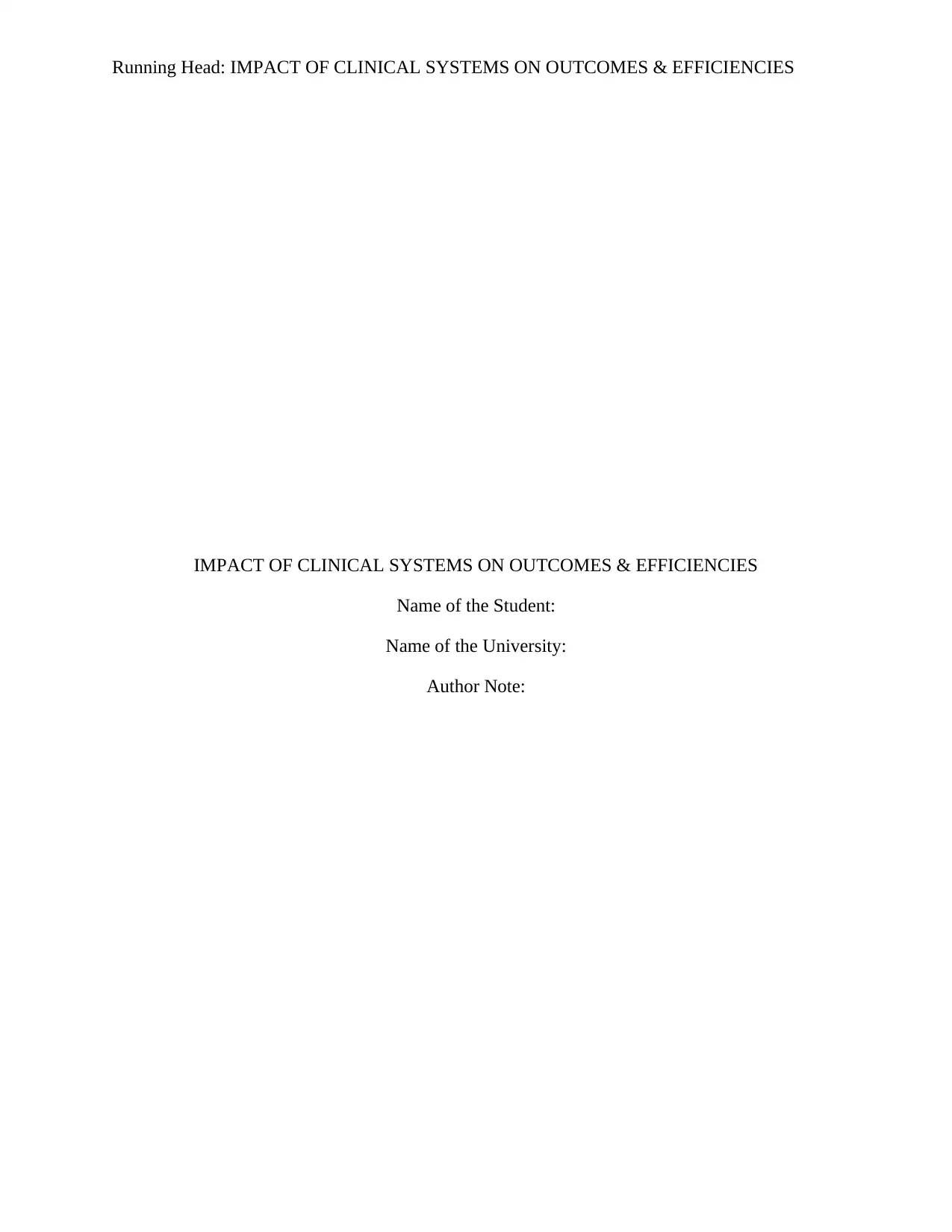
Running Head: IMPACT OF CLINICAL SYSTEMS ON OUTCOMES & EFFICIENCIES
IMPACT OF CLINICAL SYSTEMS ON OUTCOMES & EFFICIENCIES
Name of the Student:
Name of the University:
Author Note:
IMPACT OF CLINICAL SYSTEMS ON OUTCOMES & EFFICIENCIES
Name of the Student:
Name of the University:
Author Note:
Paraphrase This Document
Need a fresh take? Get an instant paraphrase of this document with our AI Paraphraser
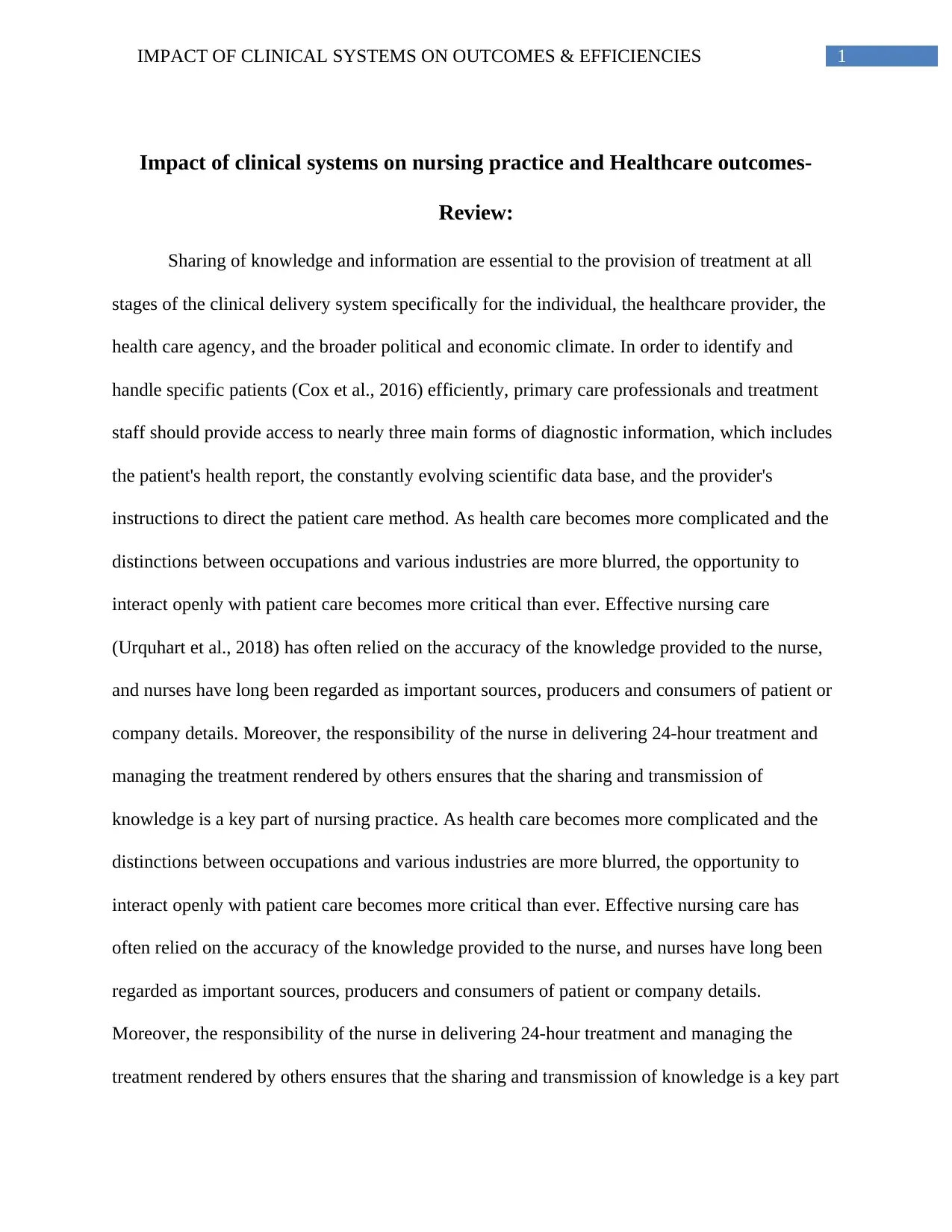
1IMPACT OF CLINICAL SYSTEMS ON OUTCOMES & EFFICIENCIES
Impact of clinical systems on nursing practice and Healthcare outcomes-
Review:
Sharing of knowledge and information are essential to the provision of treatment at all
stages of the clinical delivery system specifically for the individual, the healthcare provider, the
health care agency, and the broader political and economic climate. In order to identify and
handle specific patients (Cox et al., 2016) efficiently, primary care professionals and treatment
staff should provide access to nearly three main forms of diagnostic information, which includes
the patient's health report, the constantly evolving scientific data base, and the provider's
instructions to direct the patient care method. As health care becomes more complicated and the
distinctions between occupations and various industries are more blurred, the opportunity to
interact openly with patient care becomes more critical than ever. Effective nursing care
(Urquhart et al., 2018) has often relied on the accuracy of the knowledge provided to the nurse,
and nurses have long been regarded as important sources, producers and consumers of patient or
company details. Moreover, the responsibility of the nurse in delivering 24-hour treatment and
managing the treatment rendered by others ensures that the sharing and transmission of
knowledge is a key part of nursing practice. As health care becomes more complicated and the
distinctions between occupations and various industries are more blurred, the opportunity to
interact openly with patient care becomes more critical than ever. Effective nursing care has
often relied on the accuracy of the knowledge provided to the nurse, and nurses have long been
regarded as important sources, producers and consumers of patient or company details.
Moreover, the responsibility of the nurse in delivering 24-hour treatment and managing the
treatment rendered by others ensures that the sharing and transmission of knowledge is a key part
Impact of clinical systems on nursing practice and Healthcare outcomes-
Review:
Sharing of knowledge and information are essential to the provision of treatment at all
stages of the clinical delivery system specifically for the individual, the healthcare provider, the
health care agency, and the broader political and economic climate. In order to identify and
handle specific patients (Cox et al., 2016) efficiently, primary care professionals and treatment
staff should provide access to nearly three main forms of diagnostic information, which includes
the patient's health report, the constantly evolving scientific data base, and the provider's
instructions to direct the patient care method. As health care becomes more complicated and the
distinctions between occupations and various industries are more blurred, the opportunity to
interact openly with patient care becomes more critical than ever. Effective nursing care
(Urquhart et al., 2018) has often relied on the accuracy of the knowledge provided to the nurse,
and nurses have long been regarded as important sources, producers and consumers of patient or
company details. Moreover, the responsibility of the nurse in delivering 24-hour treatment and
managing the treatment rendered by others ensures that the sharing and transmission of
knowledge is a key part of nursing practice. As health care becomes more complicated and the
distinctions between occupations and various industries are more blurred, the opportunity to
interact openly with patient care becomes more critical than ever. Effective nursing care has
often relied on the accuracy of the knowledge provided to the nurse, and nurses have long been
regarded as important sources, producers and consumers of patient or company details.
Moreover, the responsibility of the nurse in delivering 24-hour treatment and managing the
treatment rendered by others ensures that the sharing and transmission of knowledge is a key part
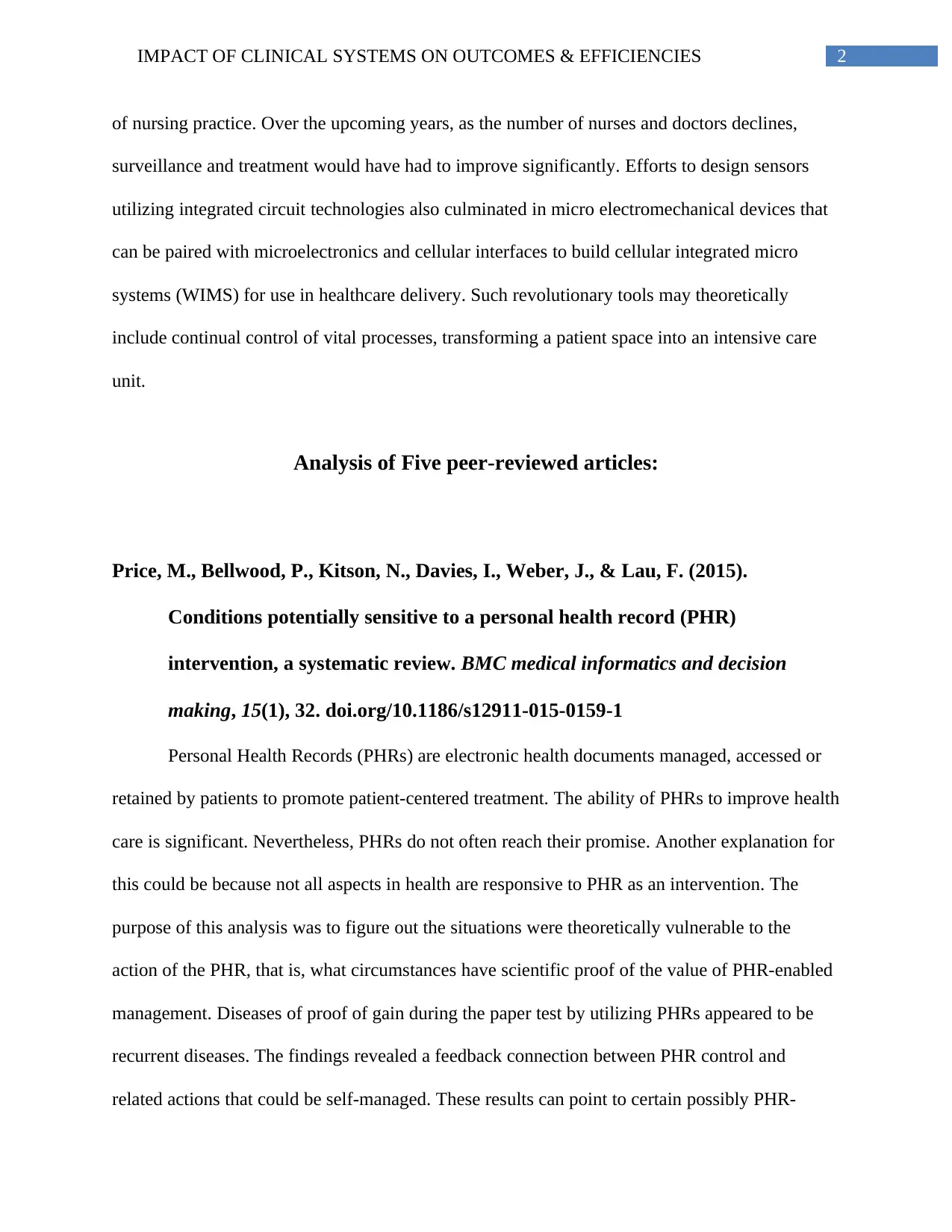
2IMPACT OF CLINICAL SYSTEMS ON OUTCOMES & EFFICIENCIES
of nursing practice. Over the upcoming years, as the number of nurses and doctors declines,
surveillance and treatment would have had to improve significantly. Efforts to design sensors
utilizing integrated circuit technologies also culminated in micro electromechanical devices that
can be paired with microelectronics and cellular interfaces to build cellular integrated micro
systems (WIMS) for use in healthcare delivery. Such revolutionary tools may theoretically
include continual control of vital processes, transforming a patient space into an intensive care
unit.
Analysis of Five peer-reviewed articles:
Price, M., Bellwood, P., Kitson, N., Davies, I., Weber, J., & Lau, F. (2015).
Conditions potentially sensitive to a personal health record (PHR)
intervention, a systematic review. BMC medical informatics and decision
making, 15(1), 32. doi.org/10.1186/s12911-015-0159-1
Personal Health Records (PHRs) are electronic health documents managed, accessed or
retained by patients to promote patient-centered treatment. The ability of PHRs to improve health
care is significant. Nevertheless, PHRs do not often reach their promise. Another explanation for
this could be because not all aspects in health are responsive to PHR as an intervention. The
purpose of this analysis was to figure out the situations were theoretically vulnerable to the
action of the PHR, that is, what circumstances have scientific proof of the value of PHR-enabled
management. Diseases of proof of gain during the paper test by utilizing PHRs appeared to be
recurrent diseases. The findings revealed a feedback connection between PHR control and
related actions that could be self-managed. These results can point to certain possibly PHR-
of nursing practice. Over the upcoming years, as the number of nurses and doctors declines,
surveillance and treatment would have had to improve significantly. Efforts to design sensors
utilizing integrated circuit technologies also culminated in micro electromechanical devices that
can be paired with microelectronics and cellular interfaces to build cellular integrated micro
systems (WIMS) for use in healthcare delivery. Such revolutionary tools may theoretically
include continual control of vital processes, transforming a patient space into an intensive care
unit.
Analysis of Five peer-reviewed articles:
Price, M., Bellwood, P., Kitson, N., Davies, I., Weber, J., & Lau, F. (2015).
Conditions potentially sensitive to a personal health record (PHR)
intervention, a systematic review. BMC medical informatics and decision
making, 15(1), 32. doi.org/10.1186/s12911-015-0159-1
Personal Health Records (PHRs) are electronic health documents managed, accessed or
retained by patients to promote patient-centered treatment. The ability of PHRs to improve health
care is significant. Nevertheless, PHRs do not often reach their promise. Another explanation for
this could be because not all aspects in health are responsive to PHR as an intervention. The
purpose of this analysis was to figure out the situations were theoretically vulnerable to the
action of the PHR, that is, what circumstances have scientific proof of the value of PHR-enabled
management. Diseases of proof of gain during the paper test by utilizing PHRs appeared to be
recurrent diseases. The findings revealed a feedback connection between PHR control and
related actions that could be self-managed. These results can point to certain possibly PHR-
⊘ This is a preview!⊘
Do you want full access?
Subscribe today to unlock all pages.

Trusted by 1+ million students worldwide
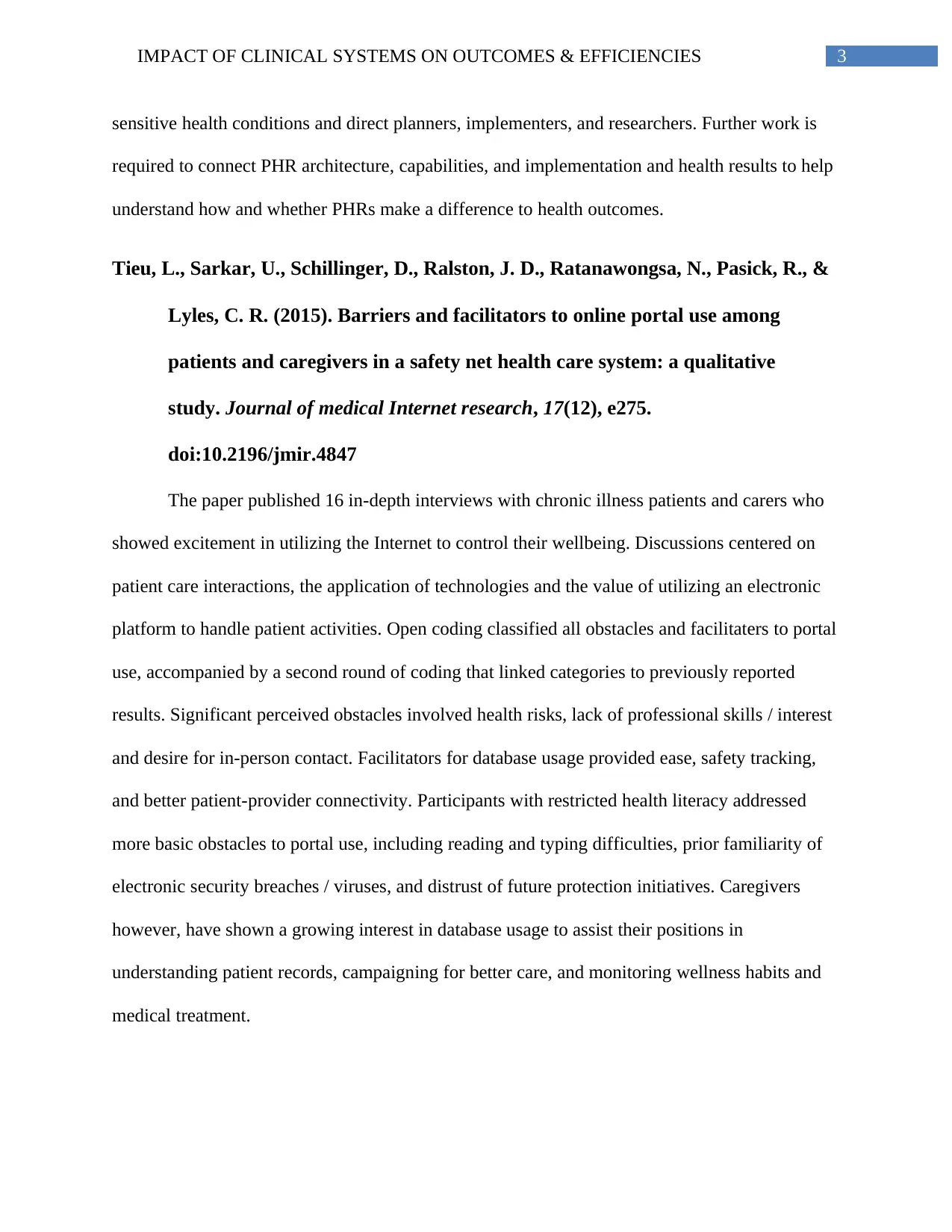
3IMPACT OF CLINICAL SYSTEMS ON OUTCOMES & EFFICIENCIES
sensitive health conditions and direct planners, implementers, and researchers. Further work is
required to connect PHR architecture, capabilities, and implementation and health results to help
understand how and whether PHRs make a difference to health outcomes.
Tieu, L., Sarkar, U., Schillinger, D., Ralston, J. D., Ratanawongsa, N., Pasick, R., &
Lyles, C. R. (2015). Barriers and facilitators to online portal use among
patients and caregivers in a safety net health care system: a qualitative
study. Journal of medical Internet research, 17(12), e275.
doi:10.2196/jmir.4847
The paper published 16 in-depth interviews with chronic illness patients and carers who
showed excitement in utilizing the Internet to control their wellbeing. Discussions centered on
patient care interactions, the application of technologies and the value of utilizing an electronic
platform to handle patient activities. Open coding classified all obstacles and facilitaters to portal
use, accompanied by a second round of coding that linked categories to previously reported
results. Significant perceived obstacles involved health risks, lack of professional skills / interest
and desire for in-person contact. Facilitators for database usage provided ease, safety tracking,
and better patient-provider connectivity. Participants with restricted health literacy addressed
more basic obstacles to portal use, including reading and typing difficulties, prior familiarity of
electronic security breaches / viruses, and distrust of future protection initiatives. Caregivers
however, have shown a growing interest in database usage to assist their positions in
understanding patient records, campaigning for better care, and monitoring wellness habits and
medical treatment.
sensitive health conditions and direct planners, implementers, and researchers. Further work is
required to connect PHR architecture, capabilities, and implementation and health results to help
understand how and whether PHRs make a difference to health outcomes.
Tieu, L., Sarkar, U., Schillinger, D., Ralston, J. D., Ratanawongsa, N., Pasick, R., &
Lyles, C. R. (2015). Barriers and facilitators to online portal use among
patients and caregivers in a safety net health care system: a qualitative
study. Journal of medical Internet research, 17(12), e275.
doi:10.2196/jmir.4847
The paper published 16 in-depth interviews with chronic illness patients and carers who
showed excitement in utilizing the Internet to control their wellbeing. Discussions centered on
patient care interactions, the application of technologies and the value of utilizing an electronic
platform to handle patient activities. Open coding classified all obstacles and facilitaters to portal
use, accompanied by a second round of coding that linked categories to previously reported
results. Significant perceived obstacles involved health risks, lack of professional skills / interest
and desire for in-person contact. Facilitators for database usage provided ease, safety tracking,
and better patient-provider connectivity. Participants with restricted health literacy addressed
more basic obstacles to portal use, including reading and typing difficulties, prior familiarity of
electronic security breaches / viruses, and distrust of future protection initiatives. Caregivers
however, have shown a growing interest in database usage to assist their positions in
understanding patient records, campaigning for better care, and monitoring wellness habits and
medical treatment.
Paraphrase This Document
Need a fresh take? Get an instant paraphrase of this document with our AI Paraphraser
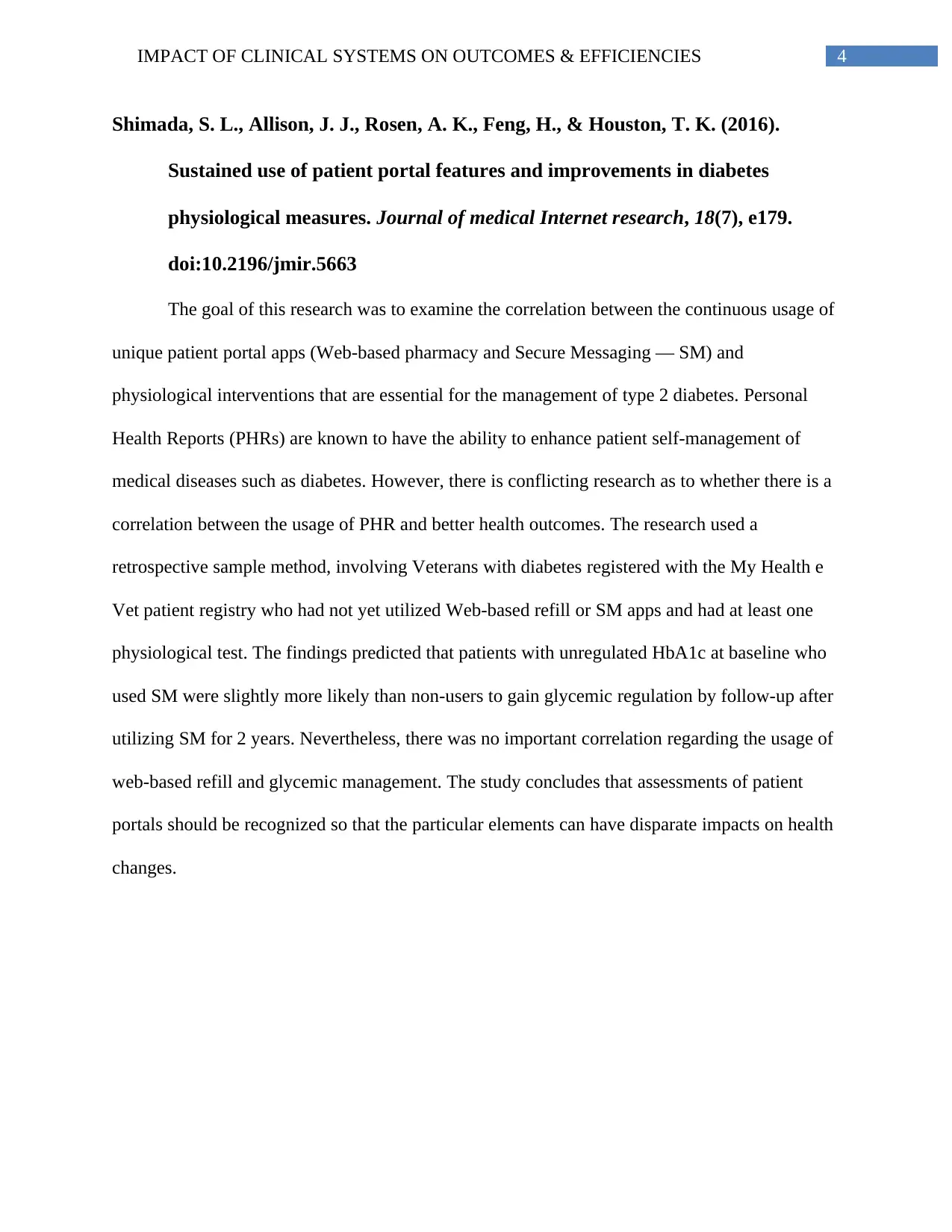
4IMPACT OF CLINICAL SYSTEMS ON OUTCOMES & EFFICIENCIES
Shimada, S. L., Allison, J. J., Rosen, A. K., Feng, H., & Houston, T. K. (2016).
Sustained use of patient portal features and improvements in diabetes
physiological measures. Journal of medical Internet research, 18(7), e179.
doi:10.2196/jmir.5663
The goal of this research was to examine the correlation between the continuous usage of
unique patient portal apps (Web-based pharmacy and Secure Messaging — SM) and
physiological interventions that are essential for the management of type 2 diabetes. Personal
Health Reports (PHRs) are known to have the ability to enhance patient self-management of
medical diseases such as diabetes. However, there is conflicting research as to whether there is a
correlation between the usage of PHR and better health outcomes. The research used a
retrospective sample method, involving Veterans with diabetes registered with the My Health e
Vet patient registry who had not yet utilized Web-based refill or SM apps and had at least one
physiological test. The findings predicted that patients with unregulated HbA1c at baseline who
used SM were slightly more likely than non-users to gain glycemic regulation by follow-up after
utilizing SM for 2 years. Nevertheless, there was no important correlation regarding the usage of
web-based refill and glycemic management. The study concludes that assessments of patient
portals should be recognized so that the particular elements can have disparate impacts on health
changes.
Shimada, S. L., Allison, J. J., Rosen, A. K., Feng, H., & Houston, T. K. (2016).
Sustained use of patient portal features and improvements in diabetes
physiological measures. Journal of medical Internet research, 18(7), e179.
doi:10.2196/jmir.5663
The goal of this research was to examine the correlation between the continuous usage of
unique patient portal apps (Web-based pharmacy and Secure Messaging — SM) and
physiological interventions that are essential for the management of type 2 diabetes. Personal
Health Reports (PHRs) are known to have the ability to enhance patient self-management of
medical diseases such as diabetes. However, there is conflicting research as to whether there is a
correlation between the usage of PHR and better health outcomes. The research used a
retrospective sample method, involving Veterans with diabetes registered with the My Health e
Vet patient registry who had not yet utilized Web-based refill or SM apps and had at least one
physiological test. The findings predicted that patients with unregulated HbA1c at baseline who
used SM were slightly more likely than non-users to gain glycemic regulation by follow-up after
utilizing SM for 2 years. Nevertheless, there was no important correlation regarding the usage of
web-based refill and glycemic management. The study concludes that assessments of patient
portals should be recognized so that the particular elements can have disparate impacts on health
changes.
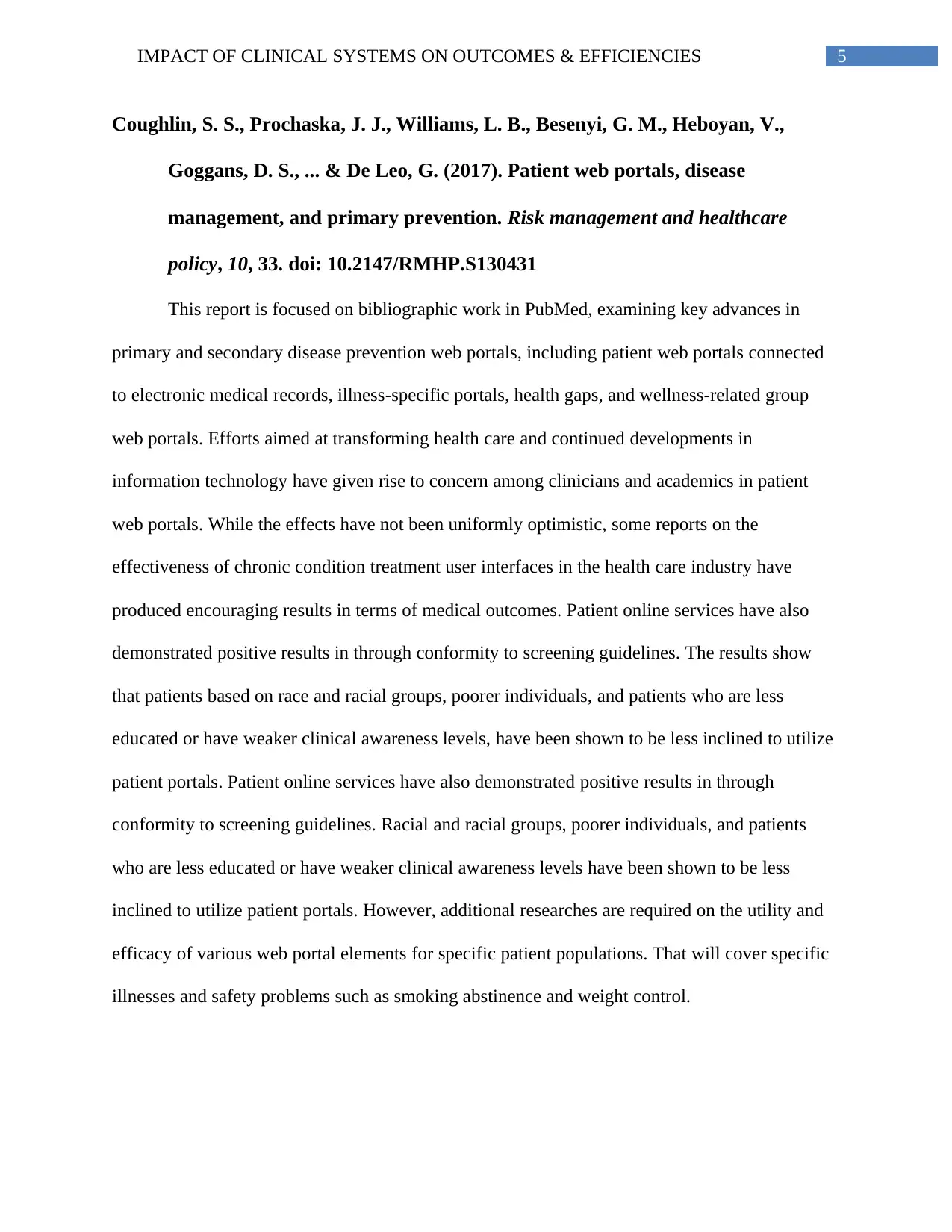
5IMPACT OF CLINICAL SYSTEMS ON OUTCOMES & EFFICIENCIES
Coughlin, S. S., Prochaska, J. J., Williams, L. B., Besenyi, G. M., Heboyan, V.,
Goggans, D. S., ... & De Leo, G. (2017). Patient web portals, disease
management, and primary prevention. Risk management and healthcare
policy, 10, 33. doi: 10.2147/RMHP.S130431
This report is focused on bibliographic work in PubMed, examining key advances in
primary and secondary disease prevention web portals, including patient web portals connected
to electronic medical records, illness-specific portals, health gaps, and wellness-related group
web portals. Efforts aimed at transforming health care and continued developments in
information technology have given rise to concern among clinicians and academics in patient
web portals. While the effects have not been uniformly optimistic, some reports on the
effectiveness of chronic condition treatment user interfaces in the health care industry have
produced encouraging results in terms of medical outcomes. Patient online services have also
demonstrated positive results in through conformity to screening guidelines. The results show
that patients based on race and racial groups, poorer individuals, and patients who are less
educated or have weaker clinical awareness levels, have been shown to be less inclined to utilize
patient portals. Patient online services have also demonstrated positive results in through
conformity to screening guidelines. Racial and racial groups, poorer individuals, and patients
who are less educated or have weaker clinical awareness levels have been shown to be less
inclined to utilize patient portals. However, additional researches are required on the utility and
efficacy of various web portal elements for specific patient populations. That will cover specific
illnesses and safety problems such as smoking abstinence and weight control.
Coughlin, S. S., Prochaska, J. J., Williams, L. B., Besenyi, G. M., Heboyan, V.,
Goggans, D. S., ... & De Leo, G. (2017). Patient web portals, disease
management, and primary prevention. Risk management and healthcare
policy, 10, 33. doi: 10.2147/RMHP.S130431
This report is focused on bibliographic work in PubMed, examining key advances in
primary and secondary disease prevention web portals, including patient web portals connected
to electronic medical records, illness-specific portals, health gaps, and wellness-related group
web portals. Efforts aimed at transforming health care and continued developments in
information technology have given rise to concern among clinicians and academics in patient
web portals. While the effects have not been uniformly optimistic, some reports on the
effectiveness of chronic condition treatment user interfaces in the health care industry have
produced encouraging results in terms of medical outcomes. Patient online services have also
demonstrated positive results in through conformity to screening guidelines. The results show
that patients based on race and racial groups, poorer individuals, and patients who are less
educated or have weaker clinical awareness levels, have been shown to be less inclined to utilize
patient portals. Patient online services have also demonstrated positive results in through
conformity to screening guidelines. Racial and racial groups, poorer individuals, and patients
who are less educated or have weaker clinical awareness levels have been shown to be less
inclined to utilize patient portals. However, additional researches are required on the utility and
efficacy of various web portal elements for specific patient populations. That will cover specific
illnesses and safety problems such as smoking abstinence and weight control.
⊘ This is a preview!⊘
Do you want full access?
Subscribe today to unlock all pages.

Trusted by 1+ million students worldwide
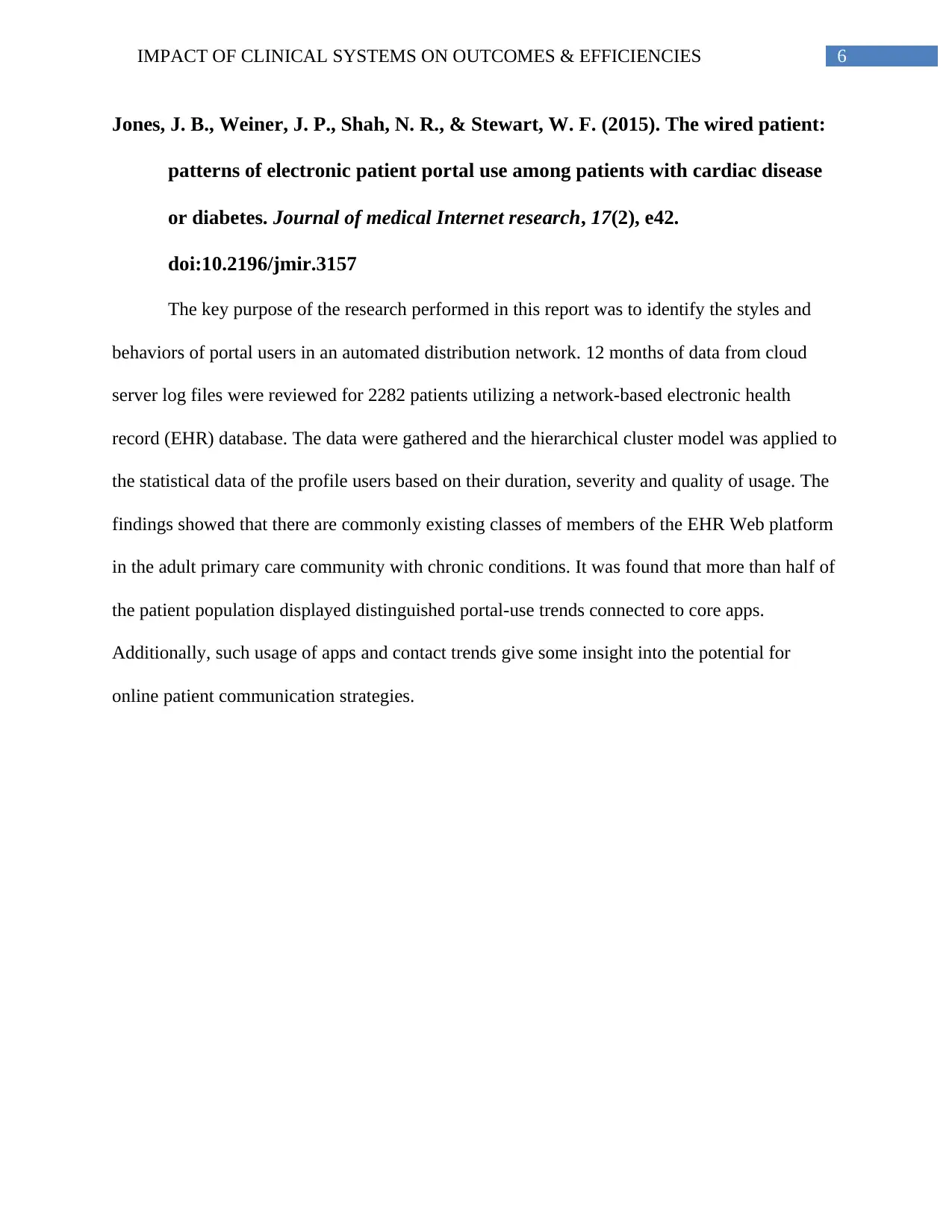
6IMPACT OF CLINICAL SYSTEMS ON OUTCOMES & EFFICIENCIES
Jones, J. B., Weiner, J. P., Shah, N. R., & Stewart, W. F. (2015). The wired patient:
patterns of electronic patient portal use among patients with cardiac disease
or diabetes. Journal of medical Internet research, 17(2), e42.
doi:10.2196/jmir.3157
The key purpose of the research performed in this report was to identify the styles and
behaviors of portal users in an automated distribution network. 12 months of data from cloud
server log files were reviewed for 2282 patients utilizing a network-based electronic health
record (EHR) database. The data were gathered and the hierarchical cluster model was applied to
the statistical data of the profile users based on their duration, severity and quality of usage. The
findings showed that there are commonly existing classes of members of the EHR Web platform
in the adult primary care community with chronic conditions. It was found that more than half of
the patient population displayed distinguished portal-use trends connected to core apps.
Additionally, such usage of apps and contact trends give some insight into the potential for
online patient communication strategies.
Jones, J. B., Weiner, J. P., Shah, N. R., & Stewart, W. F. (2015). The wired patient:
patterns of electronic patient portal use among patients with cardiac disease
or diabetes. Journal of medical Internet research, 17(2), e42.
doi:10.2196/jmir.3157
The key purpose of the research performed in this report was to identify the styles and
behaviors of portal users in an automated distribution network. 12 months of data from cloud
server log files were reviewed for 2282 patients utilizing a network-based electronic health
record (EHR) database. The data were gathered and the hierarchical cluster model was applied to
the statistical data of the profile users based on their duration, severity and quality of usage. The
findings showed that there are commonly existing classes of members of the EHR Web platform
in the adult primary care community with chronic conditions. It was found that more than half of
the patient population displayed distinguished portal-use trends connected to core apps.
Additionally, such usage of apps and contact trends give some insight into the potential for
online patient communication strategies.
Paraphrase This Document
Need a fresh take? Get an instant paraphrase of this document with our AI Paraphraser
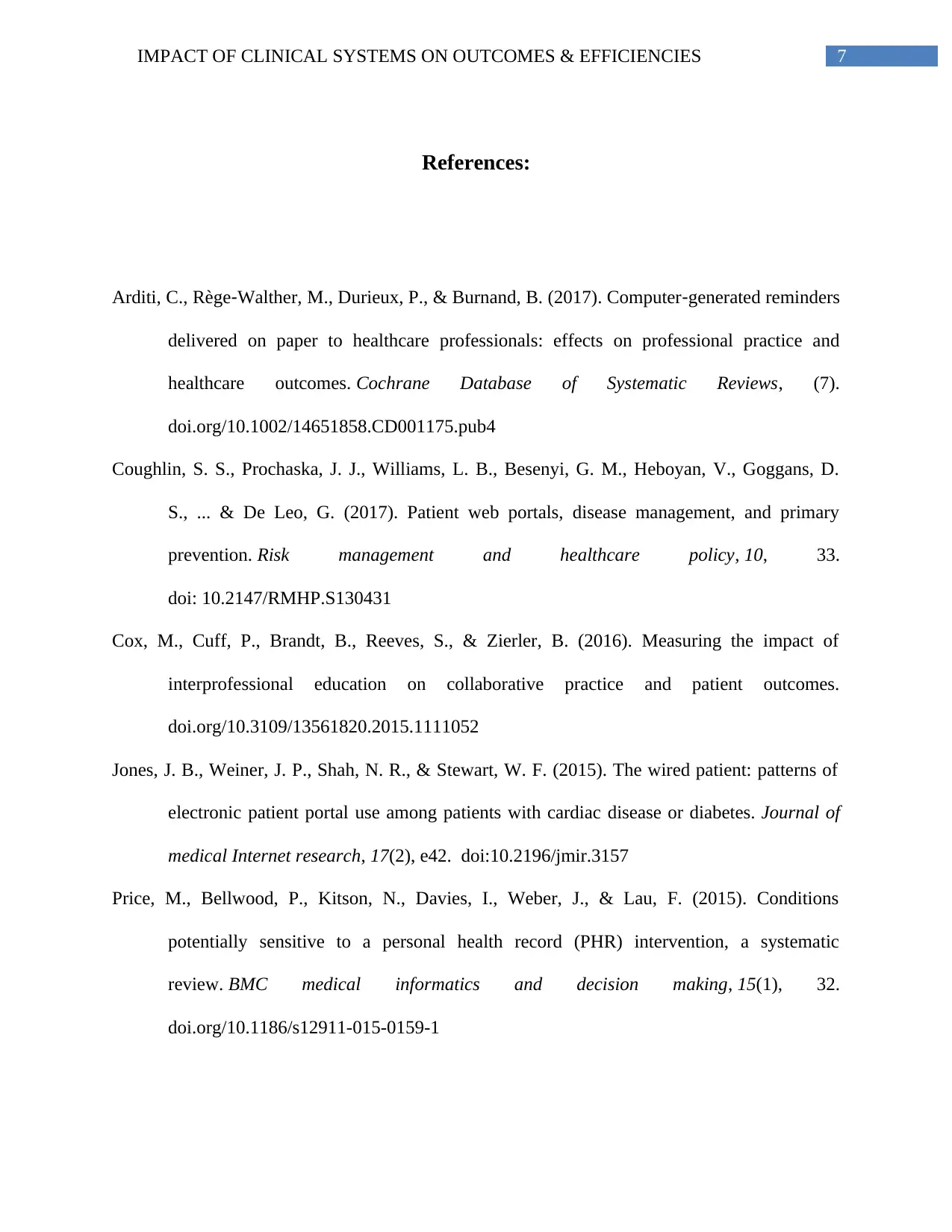
7IMPACT OF CLINICAL SYSTEMS ON OUTCOMES & EFFICIENCIES
References:
Arditi, C., Rège‐Walther, M., Durieux, P., & Burnand, B. (2017). Computer‐generated reminders
delivered on paper to healthcare professionals: effects on professional practice and
healthcare outcomes. Cochrane Database of Systematic Reviews, (7).
doi.org/10.1002/14651858.CD001175.pub4
Coughlin, S. S., Prochaska, J. J., Williams, L. B., Besenyi, G. M., Heboyan, V., Goggans, D.
S., ... & De Leo, G. (2017). Patient web portals, disease management, and primary
prevention. Risk management and healthcare policy, 10, 33.
doi: 10.2147/RMHP.S130431
Cox, M., Cuff, P., Brandt, B., Reeves, S., & Zierler, B. (2016). Measuring the impact of
interprofessional education on collaborative practice and patient outcomes.
doi.org/10.3109/13561820.2015.1111052
Jones, J. B., Weiner, J. P., Shah, N. R., & Stewart, W. F. (2015). The wired patient: patterns of
electronic patient portal use among patients with cardiac disease or diabetes. Journal of
medical Internet research, 17(2), e42. doi:10.2196/jmir.3157
Price, M., Bellwood, P., Kitson, N., Davies, I., Weber, J., & Lau, F. (2015). Conditions
potentially sensitive to a personal health record (PHR) intervention, a systematic
review. BMC medical informatics and decision making, 15(1), 32.
doi.org/10.1186/s12911-015-0159-1
References:
Arditi, C., Rège‐Walther, M., Durieux, P., & Burnand, B. (2017). Computer‐generated reminders
delivered on paper to healthcare professionals: effects on professional practice and
healthcare outcomes. Cochrane Database of Systematic Reviews, (7).
doi.org/10.1002/14651858.CD001175.pub4
Coughlin, S. S., Prochaska, J. J., Williams, L. B., Besenyi, G. M., Heboyan, V., Goggans, D.
S., ... & De Leo, G. (2017). Patient web portals, disease management, and primary
prevention. Risk management and healthcare policy, 10, 33.
doi: 10.2147/RMHP.S130431
Cox, M., Cuff, P., Brandt, B., Reeves, S., & Zierler, B. (2016). Measuring the impact of
interprofessional education on collaborative practice and patient outcomes.
doi.org/10.3109/13561820.2015.1111052
Jones, J. B., Weiner, J. P., Shah, N. R., & Stewart, W. F. (2015). The wired patient: patterns of
electronic patient portal use among patients with cardiac disease or diabetes. Journal of
medical Internet research, 17(2), e42. doi:10.2196/jmir.3157
Price, M., Bellwood, P., Kitson, N., Davies, I., Weber, J., & Lau, F. (2015). Conditions
potentially sensitive to a personal health record (PHR) intervention, a systematic
review. BMC medical informatics and decision making, 15(1), 32.
doi.org/10.1186/s12911-015-0159-1
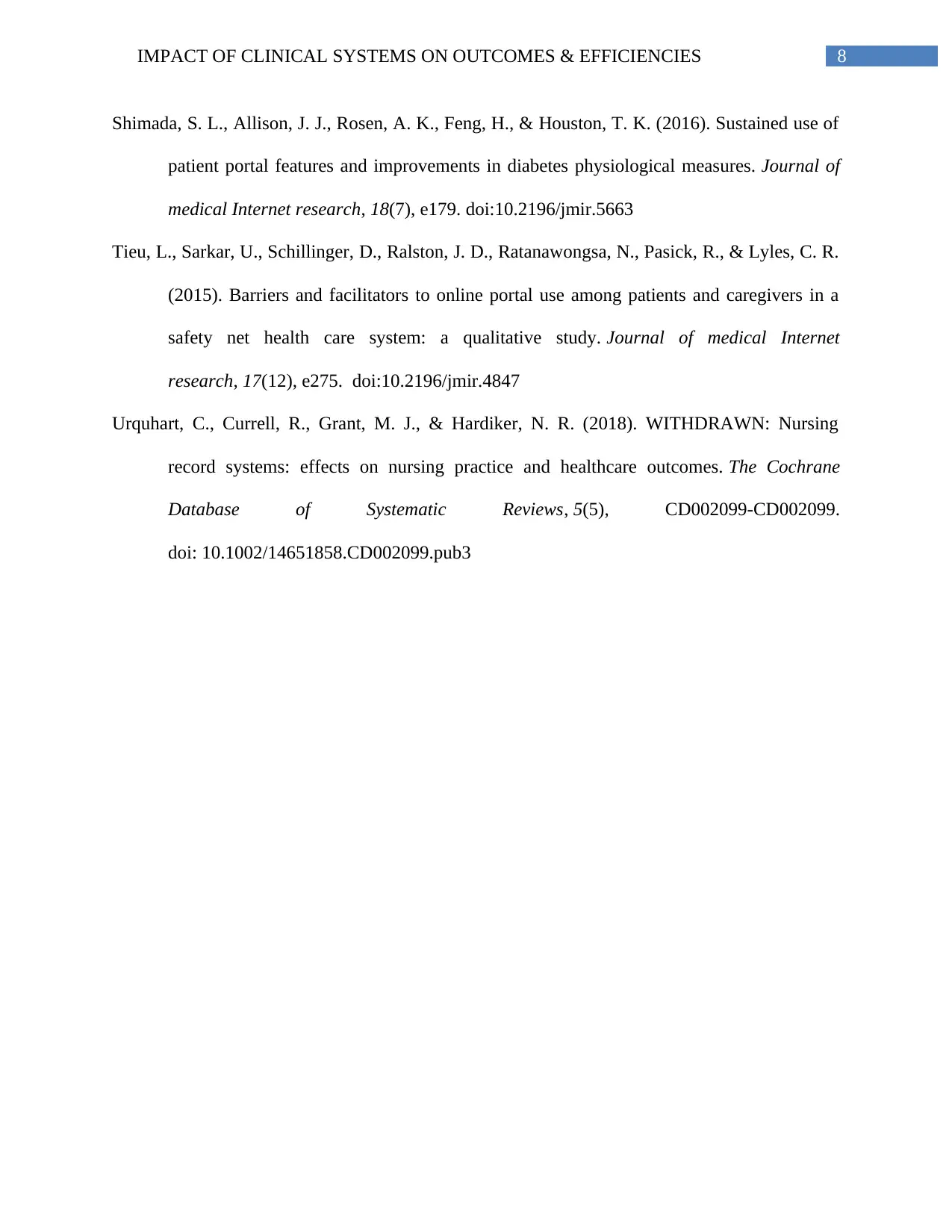
8IMPACT OF CLINICAL SYSTEMS ON OUTCOMES & EFFICIENCIES
Shimada, S. L., Allison, J. J., Rosen, A. K., Feng, H., & Houston, T. K. (2016). Sustained use of
patient portal features and improvements in diabetes physiological measures. Journal of
medical Internet research, 18(7), e179. doi:10.2196/jmir.5663
Tieu, L., Sarkar, U., Schillinger, D., Ralston, J. D., Ratanawongsa, N., Pasick, R., & Lyles, C. R.
(2015). Barriers and facilitators to online portal use among patients and caregivers in a
safety net health care system: a qualitative study. Journal of medical Internet
research, 17(12), e275. doi:10.2196/jmir.4847
Urquhart, C., Currell, R., Grant, M. J., & Hardiker, N. R. (2018). WITHDRAWN: Nursing
record systems: effects on nursing practice and healthcare outcomes. The Cochrane
Database of Systematic Reviews, 5(5), CD002099-CD002099.
doi: 10.1002/14651858.CD002099.pub3
Shimada, S. L., Allison, J. J., Rosen, A. K., Feng, H., & Houston, T. K. (2016). Sustained use of
patient portal features and improvements in diabetes physiological measures. Journal of
medical Internet research, 18(7), e179. doi:10.2196/jmir.5663
Tieu, L., Sarkar, U., Schillinger, D., Ralston, J. D., Ratanawongsa, N., Pasick, R., & Lyles, C. R.
(2015). Barriers and facilitators to online portal use among patients and caregivers in a
safety net health care system: a qualitative study. Journal of medical Internet
research, 17(12), e275. doi:10.2196/jmir.4847
Urquhart, C., Currell, R., Grant, M. J., & Hardiker, N. R. (2018). WITHDRAWN: Nursing
record systems: effects on nursing practice and healthcare outcomes. The Cochrane
Database of Systematic Reviews, 5(5), CD002099-CD002099.
doi: 10.1002/14651858.CD002099.pub3
⊘ This is a preview!⊘
Do you want full access?
Subscribe today to unlock all pages.

Trusted by 1+ million students worldwide
1 out of 9
Related Documents
Your All-in-One AI-Powered Toolkit for Academic Success.
+13062052269
info@desklib.com
Available 24*7 on WhatsApp / Email
![[object Object]](/_next/static/media/star-bottom.7253800d.svg)
Unlock your academic potential
Copyright © 2020–2025 A2Z Services. All Rights Reserved. Developed and managed by ZUCOL.





